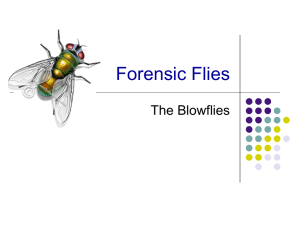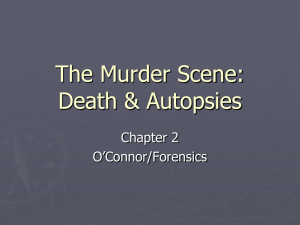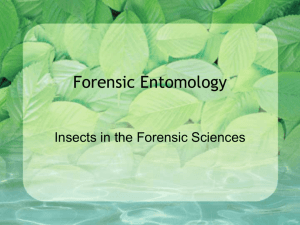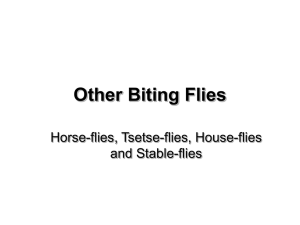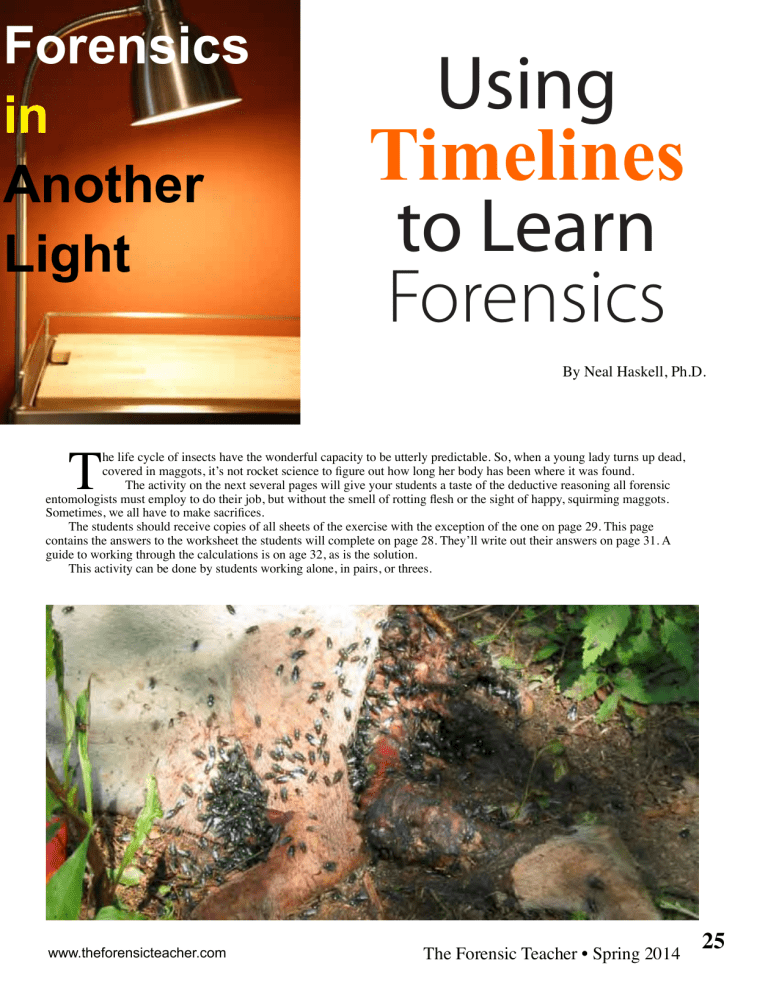
Forensics in Another Light Using Timelines to Learn Forensics By Neal Haskell, Ph.D. T he life cycle of insects have the wonderful capacity to be utterly predictable. So, when a young lady turns up dead, covered in maggots, it’s not rocket science to figure out how long her body has been where it was found. The activity on the next several pages will give your students a taste of the deductive reasoning all forensic entomologists must employ to do their job, but without the smell of rotting flesh or the sight of happy, squirming maggots. Sometimes, we all have to make sacrifices. The students should receive copies of all sheets of the exercise with the exception of the one on page 29. This page contains the answers to the worksheet the students will complete on page 28. They’ll write out their answers on page 31. A guide to working through the calculations is on age 32, as is the solution. This activity can be done by students working alone, in pairs, or threes. www.theforensicteacher.com The Forensic Teacher • Spring 2014 25 Forensic Entomology Investigation of Candi Roberts Facts and Hints: Blow flies find and colonize dead bodies very quickly after death if environmental conditions are favorable. Some species can be found on a body within seconds to minutes after death, and eggs can be found within the first hour of death if it is warm or hot. However, there is a possibility of a delay in the time from death to the first eggs which are deposited. This time can be a few minutes when it is hot to a few days if it is cold. There is usually one or two very early species of blow flies which are the very first blow flies to find a body. The egg laying (oviposition) activity will then stimulate or attract other blow flies to come to this fresh food source to lay additional eggs. These blow flies, in turn, attract many (hundreds) more to come and lay eggs on the body. This is known as oviposition frenzy. Therefore, we will have different ages of eggs, larvae, or puparia associated with any corpse. The key to a precise estimate of the time of death is to recognize which of the samples collected is the oldest and use those specimens from that sample to make the final determination as to how long the body has been dead. Specimens from younger life stages can provide a minimum time of death, but your estimate will be short of the total time the victim has been dead. When the blow flies colonize a body the preferred site for colonization is the face (mouth, nose, and eyes). Sites on the body where there has been a wound are also places where initial or early colonization will occur. However, the location where the oldest specimens are usually found is the head or face area. Blow flies do not fly and oviposite (lay eggs) at night. KAA is a protein fixative and will also kill the fly larvae. It is comprised of 1 part kerosene, 2 parts glacial acetic acid, and 8 parts 95% ETOH (ethyl alcohol). When collecting from a death scene, the larvae (maggots) are placed into this solution for a few hours to a few days, then transferred into 95% ETOH for permanent storage (preservation can be for decades). The maggot motel (fly rearing container) is usually a pint sized container with saw dust, sand or vermiculite in the bottom. An aluminum foil pouch is made in which is placed ca. (approximately) 2-3 oz. of meat product (beef liver is best, but other meat products will work) with 30 – 40 maggots placed on the liver. This pouch is then placed into the pint sized container and the larvae allowed to mature from feeding maggots to migrating maggots to puparia (the cocoon stage) to the emerging adults. These rearing containers are checked daily, and if newly hatched adults are found, they are taken from the rearing containers, placed into a small cage or net and placed into a freezer for 15 to 20 minutes to kill them. Once they are dead, they can be pinned after a few minutes or placed into permanent storage vials with 95% ETOH in the vials. They are then later identified to species and thus they confirm what species of blow flies the larvae were. Conversion to Celsius from Fahrenheit: C = 0.5556(F – 32) Degree Day and Accumulated Degree Day (DD and ADD) in Celsius Temperature (10 is the base temperature in this case) DD = (Maximum + Minimum)/2 – base temp Ex: 13 = (26 + 20)/2 - 10 Add each days accumulation to the previous total. Ex: DD1+DD2+DD3+DDn = total duration ADD ADD = DD 1 + DD 2 + DD 3 + DD n Ex: 25 = 8 + 4 + 3 + 10 DD and ADD must be calculated in ºC DD= degree day ADD= accumulated degree day DD-B10 = degree day with a base of 10°C lower limit threshold ADD-B10 = accumulated degree day with a base of 10°C lower limit threshold DH B-10 = degree hour with a base of 10°C lower limit threshold ADH-B10 = accumulated degree hour with a base of 10°C lower limit threshold You cannot calculate degree days or degree hours without a lower limit threshold, which is a temperature below which growth and development ceases. If this limit is reached, then the value for anything below this must be a value of 0 and cannot be a negative number. If you use a negative number and add them that implies the organism is actually growing younger! 26 The Forensic Teacher • Spring 2014 www.theforensicteacher.com Investigation Into the Death of Candi Roberts (Timeline) Death Investigation of Candi Roberts Goodtown, Indiana, Wonder County. Located in northeast Indiana. Remains Found: July 28, 2014, at 3:00 PM. Autopsy Conducted: July 29,2014, 9:00 AM Body Identified: Candi Roberts July 19, 2014 (6:00PM) Candi had a date with Jerry Higgins and went to a movie. July 20, 2014 (10:15PM) Friends of Candi, Kelly Bing and Sarah Smiley, went to one of the local bars in town with Candi. Candi stayed with some guys who were trying to sell the girls some meth. The other two girls, Kelly and Sarah, left the bar at about 1:30AM July 23, 2014 (4:00PM) Kelly Bing had not heard from Candi so she called her cell phone but received no answer. July 24, 2014 (10:00PM) When Candi’s roommate had not seen or heard from Candi since she left with the two girls to go to the bar on the night of the 23rd, the roommate called police and reported her missing. July 28, 2014 (3:00PM) Candi’s body was found in a wooded area known as Randall’s Woods. She was laying on her right side with three gunshot wounds to the side of her head. Decomposition was extensive with here head mostly skeltonized and large maggot mass moving into the upper torso of her body. No other wounds were seen at the time. Insect collections were made before body recovery at the scene. It was observed that maggots were beginning to leave the remains and wander into the surrounding forest leaf litter and underbrush. They were found about 8 to 10 feet from the remains in a southwesterly direction. July 29, 2014 (4:20 PM) Police Interview At this time Milton Henry stated to police that he and Candi talked briefly about the money she owed him when he saw her at the park on July 25, 2014 (7:15PM). www.theforensicteacher.com The Forensic Teacher • Spring 2014 27 Candi Roberts 2014 - 0728 NWS Station Goodtown, Indiana Temperatures Max °F Min 83 88 94 92 89 87 84 84 83 88 85 80 79 75 °F 74 76 74 77 69 63 66 65 62 65 61 71 63 58 Ta ble 1 Daily Mean °F Temperatures Max °C Min °C Daily Max/Min Temperatures from July 28, 2014 to July 15, 2014 Date 7/28/04 7/27/04 7/26/04 7/25/04 7/24/04 7/23/04 7/22/04 7/21/04 7/20/04 7/19/04 7/18/04 7/17/04 7/16/04 7/15/04 Conversion -- Celsius to Fahrenheit C = 0.5556 (F-32) DD and ADD must be calculated in ºC Use DD = (Max + Min)/2 - 10 Add each days accumulation to the previous total. DD= degree day ADD= accumulated degree day DD-B10 = degree day with a base of 10°C lower limit threshold ADD-B10 = accumulated degree day with a base of 10°C lower limit threshold DH B-10 = degree hour with a base of 10°C lower limit threshold ADH-B10 = accumulated degree hour with a base of 10°C lower limit threshold DD-B10 Student Data Table ADD-B10 Notes body found friend talked with her out with friends 10°C is the base temperature in this case DD1+DD2+DD3+DDn = total duration ADD You cannot calculate degree days or degree hours without a lower limit threshold, which is a temperature below which growth and development ceases. If this limit is reached, then the value for anything below this must be a value of 0 and cannot be a negative number. If you use a negative number and add them that implies the organism is actually growing younger! www.theforensicteacher.com The Forensic Teacher • Spring 2014 28 Candi Roberts 2014 -- 0728 Daily Mean °F 78.5 82.0 84.0 84.5 79.0 75.0 75.0 74.5 72.5 76.5 73.0 75.5 71.0 66.5 DD-B10 15.8 17.8 18.9 19.2 16.1 13.9 13.9 13.6 12.5 14.7 12.8 14.2 11.7 9.2 Table 1 Instructor Temperatures Max °C Min °C 28.3 23.3 31.1 24.4 34.4 23.3 33.3 25.0 31.7 20.6 30.6 17.2 28.9 18.9 28.9 18.3 28.3 16.7 31.1 18.3 29.4 16.1 26.7 21.7 26.1 17.2 23.9 14.4 Daily Max/Min Temperatures from July 28, 2014 to July 15, 2014 Temperatures Max °F Min °F 83 74 88 76 94 74 92 77 89 69 87 63 84 66 84 65 83 62 88 65 85 61 80 71 79 63 75 58 NWS Station Goodtown, Indiana Date 7/28/14 7/27/14 7/26/14 7/25/14 7/24/14 7/23/14 7/22/14 7/21/14 7/20/14 7/19/14 7/18/14 7/17/14 7/16/14 7/15/14 ADD-B10 15.8 33.6 52.5 71.6 87.8 101.6 115.5 129.1 141.6 156.4 169.2 183.3 195.0 204.2 Notes: body found 1500hrs friend talked with her 1900hrs out with friends 29 The Forensic Teacher • Spring 2014 www.theforensicteacher.com Phormia regina Constant temperature reading 26.7°C Stages Eggs 1st Instar 2nd Instar 3rd Instar Prepupa (migration) Pupa Total Table 2 DD-B10 From Kamal 1958 Time(hrs) S (hrs) DH-B10 ADH-B10 DD-B10 ADD-B10 16 18 11 36 84 144 309 16 34 45 81 165 309 267.2 300.6 183.7 601.2 1402.8 2404.8 267.2 567.8 751.5 1352.7 2755.5 5160.3 11.1 12.5 7.7 25.1 58.5 100.2 215.0 11.1 23.7 31.3 56.4 114.8 215.0 Time(hrs) S (hrs) DH-B10 ADH-B10 DD-B10 ADD-B10 18 20 12 40 90 168 348 18 38 50 90 180 348 300.6 334.0 200.4 668.0 1503.0 2805.6 300.6 634.6 835.0 1503.0 3006.0 5811.6 12.5 13.9 8.4 27.8 62.6 116.9 242.2 12.5 26.4 34.8 62.6 125.3 242.2 Time(hrs) S(hrs) DH-B10 ADH-B10 DD-B10 ADD-B10 24 24 20 48 128 264 508 24 48 68 116 244 508 400.8 400.8 334.0 801.6 2137.6 4408.8 400.8 801.6 1135.6 1937.2 4074.8 8483.6 16.7 16.7 13.9 33.4 89.1 183.7 353.5 16.7 33.4 47.3 80.7 169.8 353.5 Lucilia sericata Constant temperature rearing 26.7°C Stages Eggs 1st Instar 2nd Instar 3rd Instar Prepupa (migration) Pupa Total Calliphora vicina Constant temperature rearing 26.7°C Stages Eggs 1st Instar 2nd Instar 3rd Instar Prepupa (Migration) Pupa Total 30 The Forensic Teacher • Spring 2014 www.theforensicteacher.com Forensic Entomology Investigation of Candi Roberts Insect Evidence Recovered from the Body at the Scene Temperature — from climatological data sheet RESULTS OF EXAMINATION Sample #1 – 7/28/14 (1530hrs) – larvae from head area–at scene; preserved KAA (36) – mature 3rd stage larvae -- Diptera: Calliphoridae, Lucilia sericata (15) – 3rd stage larvae -- Diptera: Calliphoridae, Phormia regina Sample # 2 – 7/28/14 (1530hrs) – larvae from head area–at scene; live into maggot motel –at scene; with liver (12) – adult fly -- Diptera: Calliphoridae, Lucilia sericata reared 8/5/14 (9) – adult flies -- Diptera: Calliphoridae, Phormia regina reared 8/10/14 Sample #3 – 7/28/14 (1600hrs) – larvae from 5 feet north of head –at scene; preserved KAA (14) – migrating larvae -- Diptera: Calliphoridae, Lucilia sericata Sample #4 – 7/28/14 (1606hrs) – larvae from 5 feet north of head –at scene -- live into maggot motels with liver. (10) – adult flies -- Diptera: Calliphoridae, Lucilia sericata reared 8/3/14 Based on the above findings from the insect evidence, you, as a forensic entomologist, must provide answers to the coroner and the police as to the happenings of the case. Name(s)__________________________________________________ Date___________________ Your conclusion (and reasoning): www.theforensicteacher.com The Forensic Teacher • Spring 2014 31 Candi Roberts Murder Investigation Solution There are essentially three elements in solving a time since death (postmortem interval) cases using blow fly larvae (the most often used insect group in forensic entomology, also eggs and puparia). This is accomplished in an orderly manner moving from data set to data set. First, using larvae (usually the largest) within a stage (1st, 2nd, 3rd) determine what these oldest larvae are (early, mid, mature larvae of each stage, usually relative length to girth). Second, identify the species which comprise the sample (there could be multiple species). This may be accomplished through morphological characters of the stages of larvae, or maybe not. Some larval characteristics may not be distinguishable among/between some species, yet others are very obvious. This then necessitates rearing the larvae to the adult stage which is then definitive and also serves as a check for larval identification. Third, once the species and the oldest life stage of that species present is determined, go to the appropriate growth and development tables provided for that species. I have used data from the Kamal study (1958) which has worked in cases for over 50 years with hundreds of cases being analyzed (Table 2). These data are based upon mode of the distribution and in my opinion are extremely reliable, unlike some more recent studies focusing on the minimum time duration or research methods of establishing the data which are not fully explained in the research papers. With Table 2 we are given the mode of the distribution which provides data for the most prevalent or most frequent occurrence of the data set. Not all specimens have moulted to the next stage (eg. 2nds to 3rds), thus we are in the early portion of the change from 2nd to 3rds for example. This is the ADD-B10 value that is provided for each stage interval. Looking at the table for Lucilia sericata we find that for 3rd instar (stage) larvae it would take approximately 62 ADDs to reach into the mode of that distribution. However, if we were to find mature 3rd instar larvae, we are obviously beyond this value and require more energy units to reach this growth level. With our case, we do see mature 3rd instar larvae, but in another sample we have recovered a few migrating larvae of L. sericata and these would be even older than the mature 3rds. Therefore, since we do not have many migrating 3rds, we will use the presented data for the migrating thirds mode (125ADDs). This would be the outer value of the growth and development and we really need to provide a range of values to allow for biological variability. We could then start with halfway between the 3rd stage data and the migrating data which would be somewhere in the 95-100ADD-B10, as a minimum, out to the 125 ADD-B10 value, for our maximum. Fourth, we now consult Table 1 with our daily energy unit accumulations. We are looking for energy unit values between approximately 100ADD-B10 and 125ADD-B10. This range occurred between the 23rd and 21st. However, these values are from midnight to midnight with a portion of the data for 23rd happening after darkness so the flies could not have laid eggs at that time period, so we go back to daylight hours of the day before, that being 22nd. Also she was last known alive at (2215hrs) on the 20th. Likewise, this is during darkness and blow flies are not active at night. Therefore any colonization would have occurred following sunrise on the 21st. Thus, insect colonization and death would have been between sunrise of the 21st and no later than sunset of the 22nd. The person who said they talked with her on the 26th is either mistaken or lying. Another major variable factor, which is essential, is the environmental factors of a case, which were not brought into this exercise. Solar radiation, shading, close proximity to a stream or river or other bodies of water, burial, and a host of other variable can be taken into consideration and evaluated for their inputs into the degree day calculations and estimates. I hope you have enjoyed this exercise and the challenges concerning the variability with which forensic entomologist’s are faced with 32 The Forensic Teacher • Spring 2014 www.theforensicteacher.com
